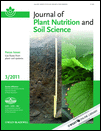Effects of cuvette surface material on ammonia-, nitrous oxide-, carbon dioxide-, and methane-concentration measurements
Abstract
Closed-chamber systems are commonly used to determine gaseous C and N emissions from agricultural soils. We investigated the effects of eight cuvette surfaces on two standard gas concentrations of NH3, N2O, CO2, and CH4 under laboratory conditions. Cuvette surface materials differentially affected gas adhesion or recovery as a function of the type and the concentration of the gases. Given the strong effects on results of gas measurements in closed-chamber systems, both the type and the concentration of the measured gases need to be considered in selecting cuvette surface materials.




